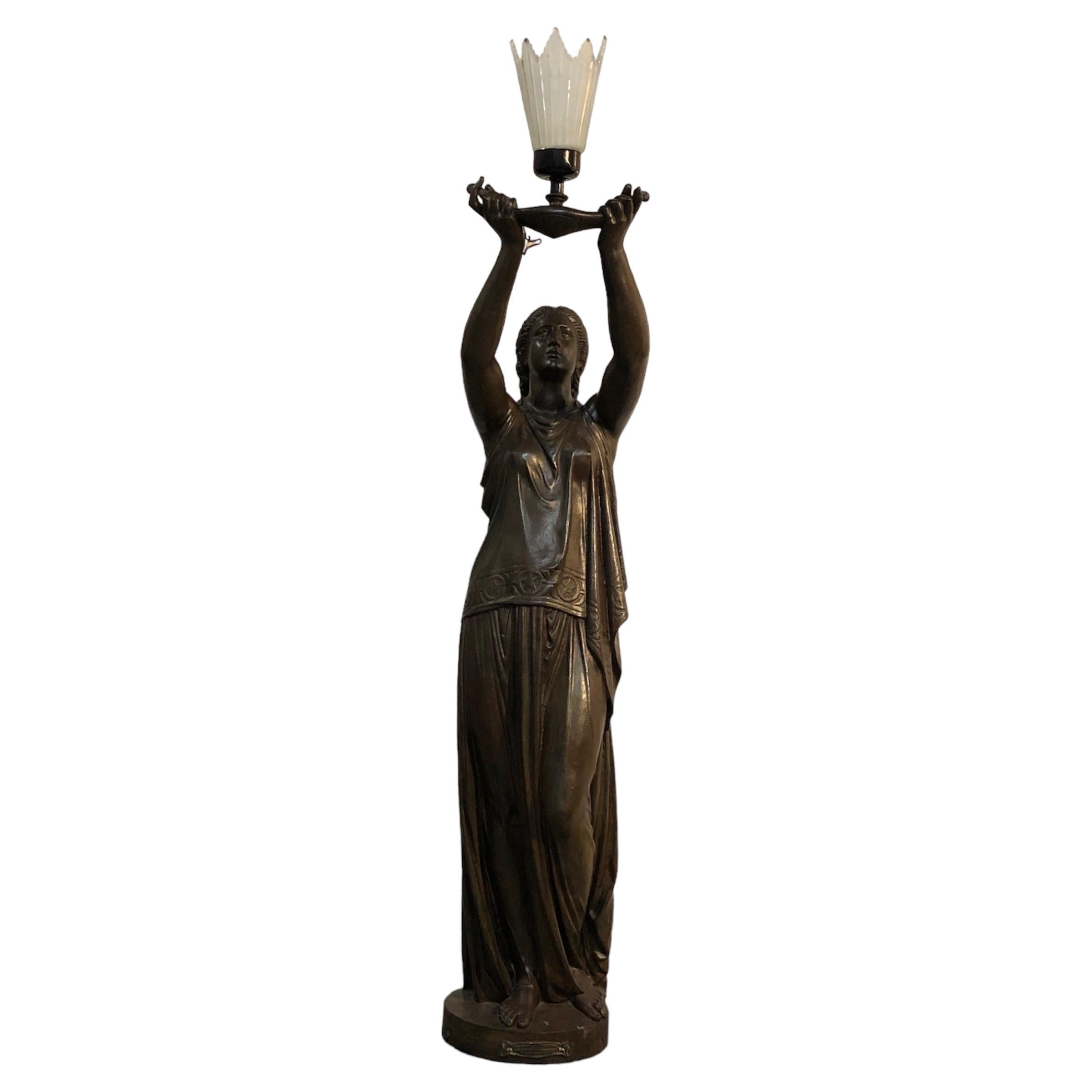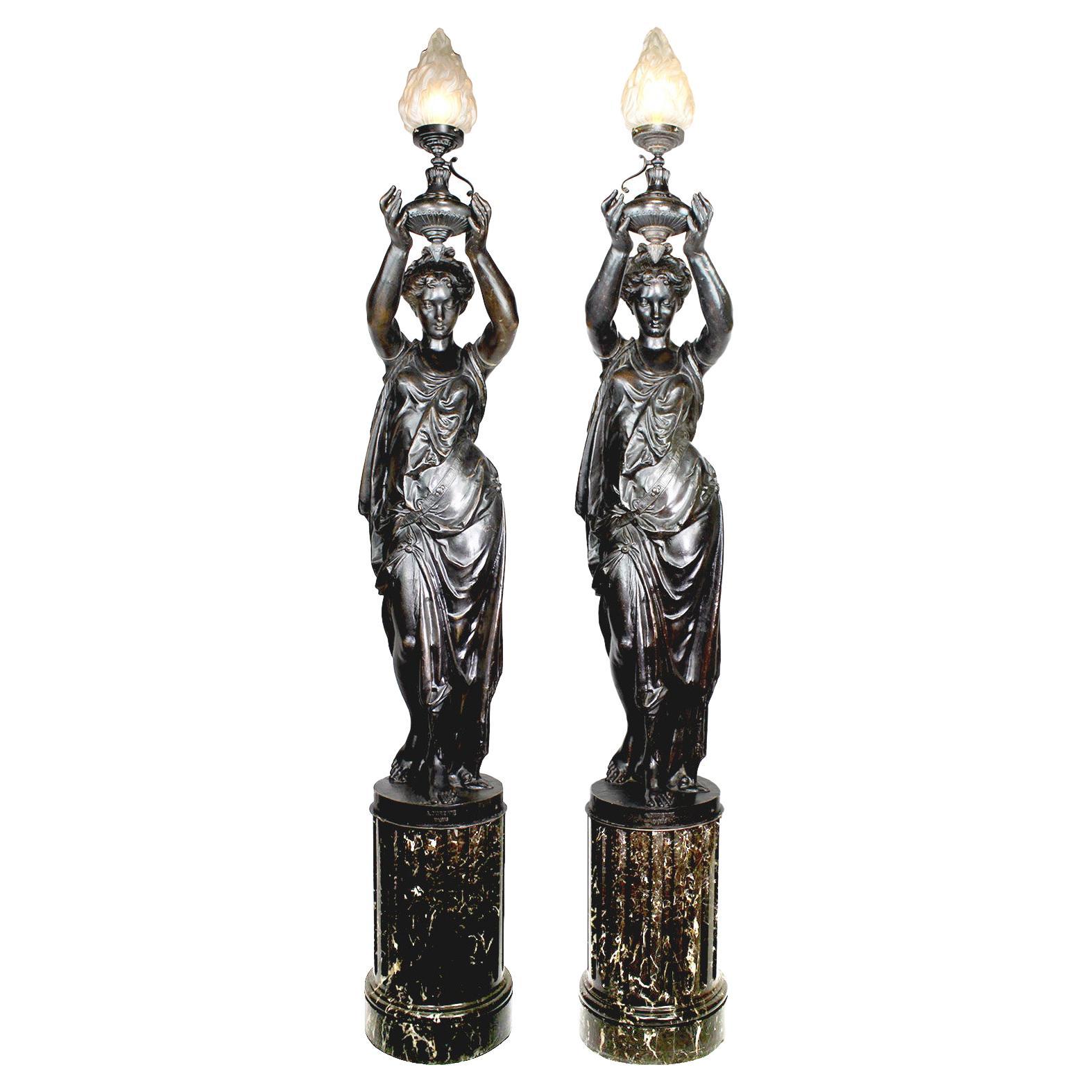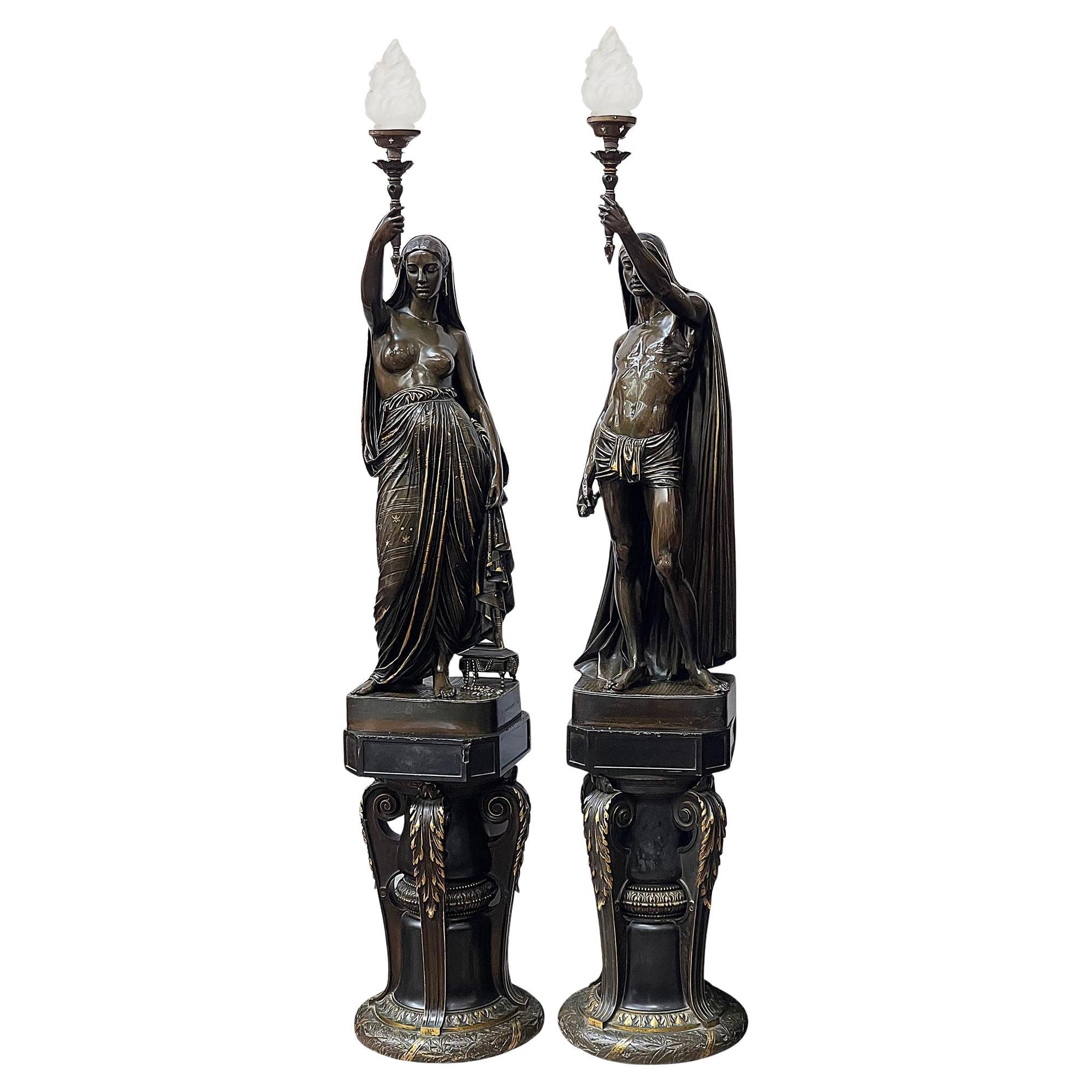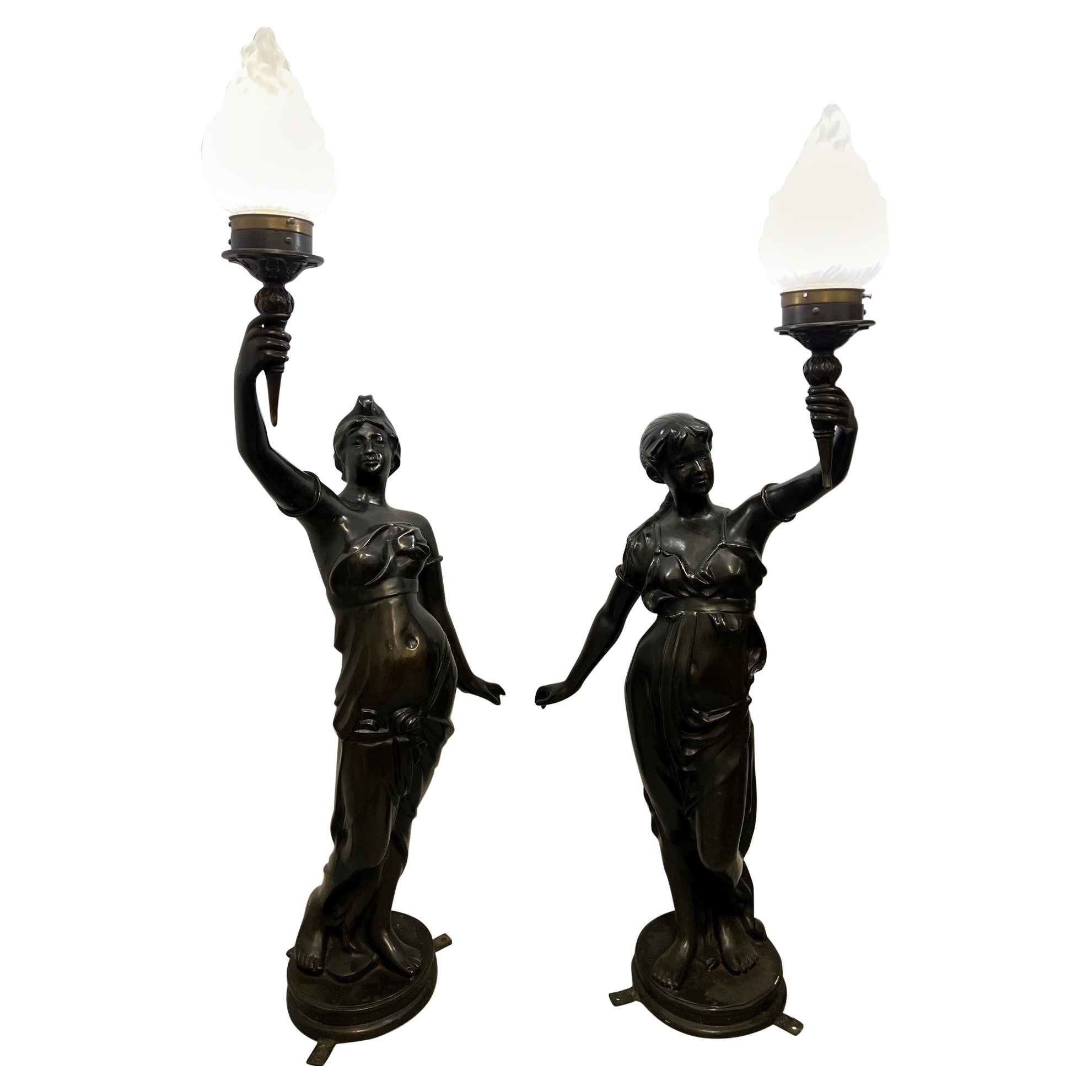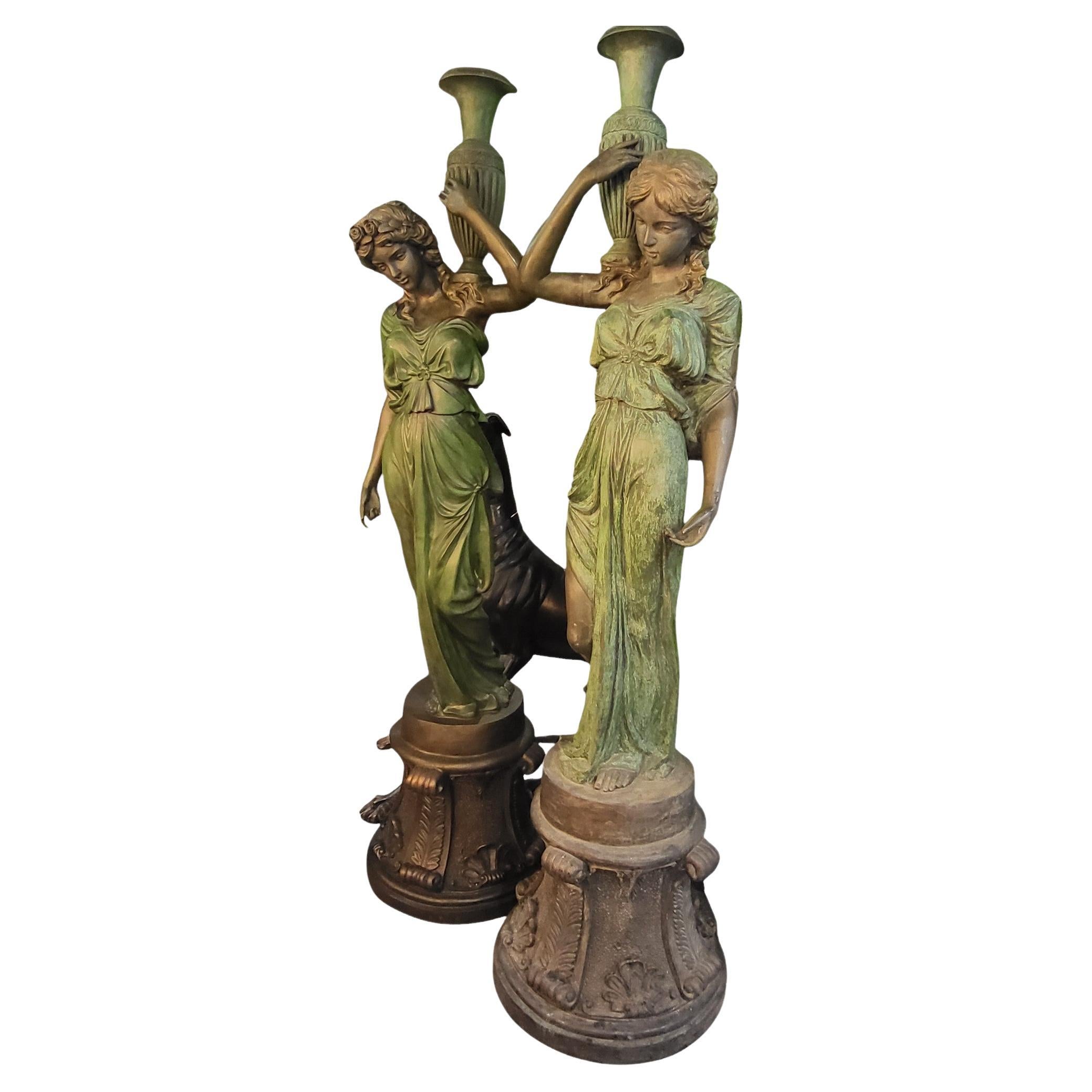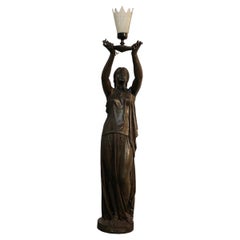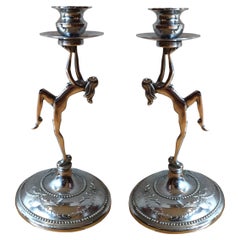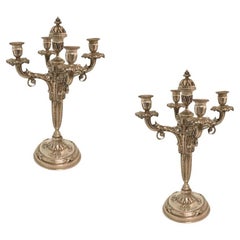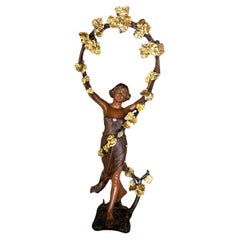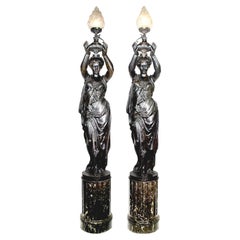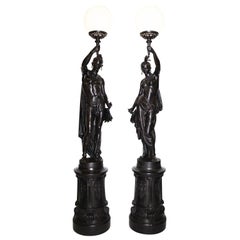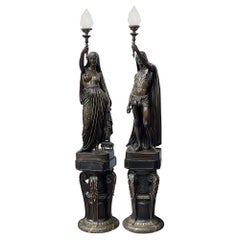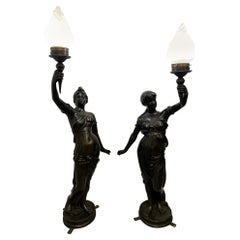Items Similar to 2 Sculptures of Women with Light by Val D'Osne 1889 " Free Shipping in Florida "
Video Loading
Want more images or videos?
Request additional images or videos from the seller
1 of 22
2 Sculptures of Women with Light by Val D'Osne 1889 " Free Shipping in Florida "
$90,000per set
£68,326.46per set
€78,150.90per set
CA$125,743.05per set
A$139,853.72per set
CHF 73,027.27per set
MX$1,701,871.02per set
NOK 932,669.64per set
SEK 874,679.58per set
DKK 583,270.12per set
Shipping
Retrieving quote...The 1stDibs Promise:
Authenticity Guarantee,
Money-Back Guarantee,
24-Hour Cancellation
About the Item
"Free shipping in florida" They were exhibited at Palm beach "American International Fine Art Fair (AIFAF)"
The sculptures are Height: 136.5 cm (53.74 inch)
Diameter: 28 cm ( 11.02 inch)
Wooden bases:
Height: 56 cm (22.04 inch)
length x length : 42 cm ( 16.53 inch)
Includes pedestals
The lampshades of the sculptures are not the original ones. We bought them without tulips.
Pushing the button that reads 'View All From Seller'. And you can see more objects to the style for sale.
Val D´OSNE
The popularity of cast iron in the second half of the 19th century was greater in france than anywhere else in Europe, where the firm of Val D'Osne had come to dominate production of cast-iron ornamentation. Officially known as Société Anonyme des Hauts-Fourneaux et Fonderies du Val-D'Osne, Anciennes maisons J. P. V. André et J. J. Ducel et Fils, the firm, commonly known simply as 'Val D'Osne', was originally founded in 1835 and developed rapidly by absorbing smaller foundries in the Haute-Marne area east of Paris. A frequent participant in the International Exhibitions, the foundry was awarded medals for their work during the latter half of the 19th century.
Why are there so many antiques in Argentina?
In the 1880 – 1940 there was a grate wave of immigration encouraged by the periods of war that were taking place.
1st World War took place between 1914 and 1918
2nd World War took place between 1939 and 1945
The immigrants options were New York or Buenos Aires. Tickets were cheap and in Buenos Aires they were welcomed with open arms, as it was a country where everything was still to be done.
Argentina was the country of new opportunities, labour was needed and religious freedom was assured, in many cases the of the family travel first until they were settled and then the rest of the family members join them.
In the immigrant museum “Ellis Island Immigrant Building” in New York you can se the promotional posters of the boats that would take them to a new life.
Between the years 1895 and 1896, Argentina had the highest DGP (gross domestic product) per capita in the world according to the Maddison Historical Statistics index, this situation arose due to the large amount of food being exported to European countries, which were at war.
The Argentinean ships left the port of Buenos Aires with food, but they returned with furniture, clothes and construction elements, (it´s common to see this the old buildings of the historic neighbourhood of San Telmo, the beams with the inscription “Made in England)”, as well as many markets that were built in Buenos Aires, such us the San Telmo Market, whose structure was brought by ship and afterwards assembled in 900 Defensa Street.
With the great influence of European immigrants living in the country, the children of the upper classes travelled to study in France, resulting in the inauguration of “La Maison Argentinienne”, on 27th of June 1928, in the international city of Paris, which hosted many Argentinians that were studying in Frace.
It´s the fourth house to be built after France, Canada and Belgium, being the first Spanish-speaking one. Still in place today (17 Bd Jourdan, 75014, Paris, France). Many of the children of these wealthy families who attended international art exhibitions, museums and art courses abroad, took a keen interest in the European style. This is why Buenos Aires was at the time referred as “The Paris of South America”.
Between the years 1890 and 1920 more than a hundred Palaces were built on Alvear Avenue the most exclusive avenue in Buenos Aires. Today some of these palaces have been transformed into museums, hotels and embassies.
In the year 1936, the Kavanagh building was inaugurated, it was the tallest reinforced concrete building in South America.
During 1994 the American Society of Civil Engineers distinguished it as an “international engineering milestone”, and it´s now considered a World Heritage of Modern Architecture.
At the time was common to hire foreign architects such as Le Corbusier, who visited Buenos Aires/Argentina in 1929 and in 1948 he drew up the blueprints for a house built in La Plata City (which was declared a World Heritage Site).
In 1947, the Hungarian architect Marcelo Breuer designed “Parador Ariston” in the seaside city of Mar del Plata. After an Argentinean student at Harvard University convinced him to come to Argentina. He worked on an urban development project in the Casa Amarilla, area of La Boca.
The Ukrainian architect, Vladimiro Acosta, arrives in Argentina in 1928 and worked as an architect until que moved to Brazil.
Antonio Bonet, a Spanish architect who worked with Le Corbusier in Paris, arrives in Argentina in 1937, where he carried out several architectural works and in 1938 designs the well-known BFK chair.
Andres Kálnay, of Hungarian origin, made around 120 architectural masterpieces, among which the former Munich brewery stands out, he even made the furniture’s design.
The German architect, Walter Gropius, director of the Bauhaus, lived in Argentina, where he wrote articles for “Sur” magazine and founded in Buenos Aires, an architectural firm with Franz Möller, who was also an architect, where he built two houses.
At the same time several famous designers decided to immigrate to Argentina, among them we can find the well-known French designer, Jean-Michel Frank, who arrived in the country in 1940 and also worked for the Rockefeller family.
Special pieces were made, which were sold exclusively in the country, such as the well-known German company “WMF”, who sold their products by catalogue, which were chosen by the ladies of high society in the list of wedding gifts, as well as the pieces designed by Christofle.
The Swiss sculptor Alberto Giacometti, made special pieces for Argentinean mansions.
In 1904 the first Jansen branch outside Paris was established in Buenos Aires, as the Argentinean clientele demanded a large amount of furniture, from the end of the 19th century to the mid-20th century.
In 1970, the brand Rigolleau Argentina made pieces authorised by Lalique.
The brands Maple and Thompson also set up shop in the country.
The French plastic artist, Marcel Duchamp moved to Argentina in 1918-1919.
Glass signed Gallé, Charder, Leverre, Schneider, Muller and other French firms. They were bought in flower shops and were given to ladies with beautiful floral arrangements.
Some furniture manufacturers travelled to international fairs and bough the patterns to produce the furniture in Argentina, such as the furniture firm Englander and Bonta, who bought the patterns ins Italy.
It is worth mentioning that in Argentina we have the largest community of Italians outside of Italy, as it is estimated that 70 percent of the inhabitants have at least one Italian descendant, followed by Spanish immigrants.
The most Important furniture stores in Argentina:
Comte is founded in 1934 (under the direct management of Jean Michel Frank in 1940).
Nordiska (Swedish company established in 1934).
Churba in 1960, a company that brought foreign designers to present their furniture in the country:
Denmark: (Arne Jacobsen, Finn Juhl, Bender Madsen, Ejner Larsen, Poul Kjaerholm, Hans Wegner)
Sweden: (Hans Agne Jakobsson, Gustavsberg)
United States: (Herman Miller)
Finland: (Lisa Johansson, Folke Arstrom, Tapio Wirkkala, Alvar Aalto, Timo Sarpaneva)
Swedish Factory: (Orrefors)
Italy: (Littala, Vico Magistretti, Emma Gismondi, Gae Aulenti, Angelo Mangiarotti, Elio Martinelli, Gianna Celada, Angelo Mangiarotti, Mario Bellini, Carlo Scarpa)
Finland: (Olivia Toikka)
Plata Lappas (Lappas Silver): a goldsmith shop founded in 1887 in Argentina by Alcibiades Lappas of Greek origin.
In 2019, in Argentina took place “the Art Deco world congress”, in which we participated as hosts invited by Geo Darder, founder of the Copperbridge – Foundation, in which prominent people from all over the world attended to learn about Art Deco in Argentina.
Argentina currently has more than 100 Art Deco buildings and another 90 Art Nouveau buildings throughout the city of Buenos Aires.
Argentina is a country that has not been involved in many wars, which is why it has been a refuge for works of art and antiques from different periods of time, unlike European countries. That is way many collectors, museums and antique dealers from all over the world visit it, you should not miss the opportunity to visit this great country.
Laura Guevara Kjuder, architect.
- Creator:Val D'Osne Foundry (Manufacturer)
- Dimensions:Height: 53.75 in (136.5 cm)Diameter: 11.03 in (28 cm)
- Sold As:Set of 2
- Style:Greco Roman (Of the Period)
- Materials and Techniques:
- Place of Origin:
- Period:
- Date of Manufacture:1889
- Condition:Wear consistent with age and use.
- Seller Location:Ciudad Autónoma Buenos Aires, AR
- Reference Number:Seller: L-HL-2111stDibs: LU6785228916942
About the Seller
5.0
Vetted Professional Seller
Every seller passes strict standards for authenticity and reliability
Established in 1982
1stDibs seller since 2022
37 sales on 1stDibs
Typical response time: <1 hour
- ShippingRetrieving quote...Shipping from: Hollywood, FL
- Return Policy
Authenticity Guarantee
In the unlikely event there’s an issue with an item’s authenticity, contact us within 1 year for a full refund. DetailsMoney-Back Guarantee
If your item is not as described, is damaged in transit, or does not arrive, contact us within 7 days for a full refund. Details24-Hour Cancellation
You have a 24-hour grace period in which to reconsider your purchase, with no questions asked.Vetted Professional Sellers
Our world-class sellers must adhere to strict standards for service and quality, maintaining the integrity of our listings.Price-Match Guarantee
If you find that a seller listed the same item for a lower price elsewhere, we’ll match it.Trusted Global Delivery
Our best-in-class carrier network provides specialized shipping options worldwide, including custom delivery.More From This Seller
View AllSculpture of Women with Light by Val D'Osne
By Val D'Osne Foundry
Located in Ciudad Autónoma Buenos Aires, C
They were exhibited at Palm beach "American International Fine Art Fair (AIFAF)"
Sculpture with lampshade Height: 162 cm (63.77 inch)
Sculpture Height: 142 cm (55.90 inch)
Diameter: 30 cm ( 11.81 inch)
The lampshade of the sculpture are not the original. We bought it without a lampshade. He has a missing finger.
Pushing the button that reads 'View All From Seller'. And you can see more objects to the style for sale.
Val D´OSNE
The popularity of cast iron in the second half of the 19th century was greater in france than anywhere else in Europe, where the firm of Val D'Osne had come to dominate production of cast-iron ornamentation. Officially known as Société Anonyme des Hauts-Fourneaux et Fonderies du Val-D'Osne, Anciennes maisons J. P. V. André et J. J. Ducel et Fils...
Category
Antique 1880s French Greco Roman Statues
Materials
Iron
Pair of Women Candelabras, Sign, Made in England, Art Deco
Located in Ciudad Autónoma Buenos Aires, C
Pair of Candelabras
Material: Silverplated
We have specialized in the sale of Art Deco and Art Nouveau and Vintage styles since 1982. If you have any questions we are at your dis...
Category
Vintage 1930s English Art Deco Candelabras
Materials
Iron
Pair of Candelabras, Jugendstil, Art Nouveau, France, Sign, A. Marionnet
By Albert Marionnet
Located in Ciudad Autónoma Buenos Aires, C
Pair of Candelabras
Sign: A. Marionnet (Albert Marionnet)
Metal: Silver plated
We have specialized in the sale of Art Deco and Art Nouveau and Vintage styles since 1982.If you h...
Category
Antique Early 1900s French Art Nouveau Candelabras
Materials
Metal
"Vendimia woman " Sculpture , Year :1890, Jugendstil, Art Nouveau, Liberty
Located in Ciudad Autónoma Buenos Aires, C
We have specialized in the sale of Art Deco and Art Nouveau and Vintage styles since 1982. If you have any questions we are at your disposal.
Pushing the button that reads 'View All ...
Category
Antique 1890s French Art Nouveau Figurative Sculptures
Materials
Bronze
Woman, Austria, Material, Bronze and Marble, Sign, K. Sterrer Wiens
Located in Ciudad Autónoma Buenos Aires, C
Bronze Sculpture.
Karl Sterrer
Date of birth December 4, 1885
Birthplace Vienna
Date of death June 10, 1972
Place of death Vienna
Professional painter....
Category
Vintage 1920s Austrian Art Nouveau Animal Sculptures
Materials
Marble, Bronze
Sculpture Woman in Bronze and Marble Guss Wollenbergu Schuttz
Located in Ciudad Autónoma Buenos Aires, C
Sculpture Woman in Bronze and Marble
Guss Wollenbergu Schuttz
We have specialized in the sale of Art Deco and Art Nouveau and Vintage styles since 1982. If you have any questions we...
Category
Antique Early 1900s German Classical Roman Figurative Sculptures
Materials
Marble, Bronze
You May Also Like
Pair of French 19th-20th Century Neoclassical Style Cast Iron Figural Torchères
Located in Los Angeles, CA
A very fine pair of French 19th-20th century neoclassical style patinated cast iron figural torchères by A. Durenne, Paris, each representing a figure of a standing young maiden, her arms raised forward while holding a a flaming urn gas light (Now electrified) with a frosted glass flame, each raised on a veined grey marble column stand, both cast-signed 'A. Durenne, Paris'. Antoine Durenne was an internationally renowned French art founder. He attended École Nationale Supérieure des Beaux-Arts in 1842. Durenne purchased a small foundry in Sommevoire, near the Val d'Osne, Haute-Marne, France and established The Durenne firm, circa Paris, 1900.
Cast-iron had been in production during the 18th century but its inferior status to the more fashionable and delicate wrought iron had generally confined its use to architectural work. By the early 19th century, however, rapid developments of the Industrial Revolution combined with the simultaneous burgeoning of a new middle class provided the impetus for a dramatic Expansion in its application and in a short space of time a proliferation of iron foundries across Europe and America thrived on the production of everything from inkstands to railway stations. The use of cast-iron for garden ornament became particularly widespread at this time, as the possibilities for its mass-production at a fraction of the cost of bronze made it the material of choice for outdoor statuary...
Category
Antique Early 1900s French Neoclassical Revival Figurative Sculptures
Materials
Marble, Iron
$49,875 Sale Price / set
41% Off
Pair of French 19th Century Lifesize Cast-Iron Sculpture Torcheres, Val d'Osne
By Val D'Osne Foundry
Located in Los Angeles, CA
A superb quality and palatial pair of French 19th century lifesize cast-iron sculptures - torcheres of Native American Indians titled "L’ Indienne" designed by Jules Salmson (French, 1823-1902) and Cast by Le Fonderies d'Art du Val d'Osne, each standing figure representing a Native American Indian male and a female scantily dressed in their native robes, one arm raised holding a light-torch with an opaline glass globe, both wearing earrings, seashell necklaces and arm-braces, raised on cylindrical cast-iron stand. Signed/cast on each pedestal: “VAL D’OSNE”. (Electrified). Paris, circa 1870-1880.
Overall hHeight: 127 inches (322.6 cm)
Pedestal height: 39 inches (99.1 cm)
Indian man's width: 22 inches (55.9 cm)
Indian man's depth: 26 3/4 inches (68 cm)
Indian woman's width: 28 inches (71.1 cm)
Indian woman's depth: 25 inches (63.5 cm)
These fantastic and impressive pair of cast-iron sculptures, most likely representing Hiawatha and Minnehaha, were probably comissioned to Le Fonderies d'Art du Val d'Osne for export to the America's to decorate governmental buildings and parks which makes these pair a rare find and now available for a private collection. Iron sculptures were preferred over bronze for outdoor park and building decorations for their long lasting resistance to all types of weather conditions.
An identical pair of sculptures, also by Val d' Osne, are currently exhibited at the National Garden of Congress in Santiago, Chile. View Pages No. 87, 88, 89.
Another identical pair are also currently exhibited at The Musée de la Ville - Indian Museum "O Indio do Museo da Cidade" in Rio de Janeiro, Brazil.
Another identical pair decorate the front of the Ópera Teatro Amazonas, Manaús, Brazil.
A single figure of the female Indian...
Category
Antique 19th Century French Tribal Figurative Sculptures
Materials
Iron
$148,000 Sale Price / set
20% Off
A large pair French 19th century patinated bronze figural torchès
By F. Barbedienne Foundry, François-Christophe-Armand Toussaint
Located in Brighton, Sussex
François-Christophe-Armand Toussaint (1806-1862) A large pair of French mid-19th century gilt and patinated bronze figural torchères: Esclave Indien and Esclave Indienne
cast by F. Barbedienne (before 1869) from models by Toussaint dated 1850
the male and female figures each holding aloft glass flame shades, on panelled chamfered rectangular black marble plinths, the bronze pedestals of cylindrical baluster form with acanthus leaf collars and four engaged foliate scroll corbel supports with fluted ornament, on circular socles cast in the form of ribbon-bound laurel garlands, each signed A.Toussaint 1850 and Fondeur F.Barbedienne, 36cm wide, 36cm deep, 217cm high (14in wide, 14in deep, 85in high). the figures 112cm high (44in high
Armand Toussaint first exhibited a plaster model at the 1847 Salon in Paris entitled "Un esclave indien portant une torche" along with its female pendant...
Category
Antique Mid-19th Century French Abstract Sculptures
Materials
Bronze
Pair of Bronze Woman Torcheres
Located in Stamford, CT
Beautiful pair of bronze figural torchieres of two women holding torches which are electrified. This is a classic pair of draped bronze women holding aloft a flamed torch. The pair w...
Category
Late 20th Century Thai Figurative Sculptures
Materials
Bronze
$7,950 / set
Nice Pair of 7ft Bronze Classical Maidens
Located in London, GB
Large Pair of Bronze Classical Maidens Holding A Urn
These originally were part of a Fountain
But could be used as Free Standing Sculptures and Wired to a Fountain
Category
20th Century Unknown Classical Roman Figurative Sculptures
Materials
Bronze
A Pair of French Bronze Figures by Louis Valentin Elias Robert
By Louis Valentin Elias Robert
Located in Sheffield, MA
A Fine Pair of French Bronze Classical Figures
Now Mounted as Lamps
By Louis Valentin Elias Roberts
French 1821-1874
Signed. L.V.E. Robert, each a ...
Category
Antique 19th Century French Table Lamps
Materials
Bronze
$9,600 Sale Price / set
33% Off
More Ways To Browse
Antique French Statue
Used Furniture Florida
Antique Sculpture Statue
Antique Italian Statues
Antique Street Light
Old Antique Statues
Wooden Statues
French Street Light
Antique Black Statues
Paris Street Light
Lighted Statue
Small Antique Statue
Made In Italy Statues
Used Religious Statues
Roman Furniture Company
Antique Greek Statue
Statue On Pedestal
Antique Religious Statues
